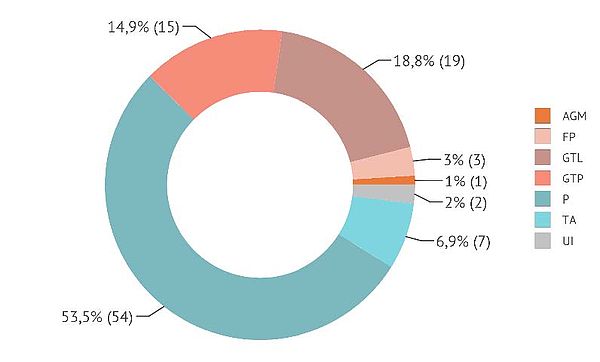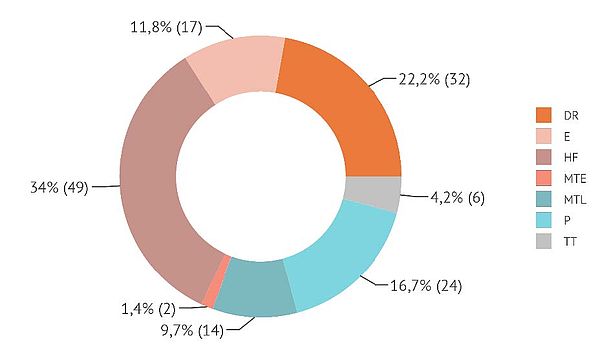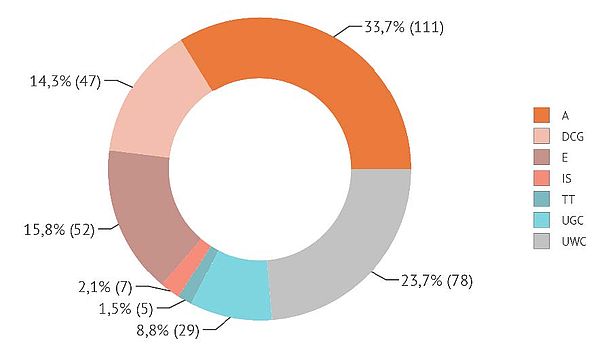Key indicators of patenting activity in the field of unconventional gas production in 2018 are considered in the present review. For this purpose, slightly more than 500 patent applications registered in patent offices around the world and related to main sectors of unconventional gas production, including associated petroleum gas (APG), coal bed methane (CBM) and methane hydrates (GHD) were collected from generally-accessible sources. Patent applications were assigned to specific topics exclusively on the basis of the information stated by applicants in the texts of patent application. The largest number of applications in 2018 was found in the field of GHD – 279, for CBM this number was substantially smaller – 128, and 94 applications on APG. In recent years applicants' activity in the development of novel technical solutions in the form of patent applications related to the field of APG and CBM production decreased noticeably. On the other hand, for GHD a considerable growth in patenting activity can be seen in 2018. The reduction in the number of patent applications found in APG and CBM industries for 2018 probably relates to their late publication in generally-accessible sources, such as Google Patent or Espacenet. However, a similar trend could also be seen in the patent office of Australia for CBM, where commercial production of this type of unconventional gas has shown steady growth in recent years. However, the number of registered patent applications here has decreased by more than three times after the peak in 2016.
A breakdown of patent documents found by the leading patent offices of the world is provided below. The subject related to CBM had the broadest geographical coverage – 17 patent offices.
Distribution of patent applications, published by the top patent offices
| Office | APG | CBM | GHD | Total 2018 |
|---|---|---|---|---|
| CNIPA (CN) | 20 | 5 | 177 | 202 |
| USPTO (US) | 20 | 44 | 18 | 82 |
| EPO | 10 | 17 | 8 | 35 |
| WIPO | 6 | 5 | 23 | 34 |
| INPI (BR) | 8 | 11 | 5 | 24 |
| JPO (JP) | 7 | - | 14 | 21 |
| MyIPO (MY) | 12 | 9 | - | 21 |
| IP Australia (AU) | 2 | 11 | 5 | 18 |
| NIPO (NO) | - | 3 | 7 | 10 |
| IPO (GB) | - | 5 | 4 | 9 |
| IMPI (MX) | - | 5 | 2 | 7 |
| ROSPATENT (RU) | 3 | 3 | 1 | 7 |
| CIPO (CA) | - | 1 | 5 | 6 |
| KIPO (KR) | 1 | - | 3 | 4 |
Source: Advanced Energy Technologies
The most highly-demanded patent office with inventors was Chinese CNIPA, where 40% of the total number of patent applications on all three subjects was concentrated. 87% of patent applications registered in this office were dedicated to methane production from hydrates. Other patent offices of those leading in terms of the number of registered applications (USPTO (US) and EPO) demonstrate a more balanced distribution of documents in the three subjects.
The following table shows patenting activity data for countries around the world, evaluated by the number of patent applications filed by the applicants who are residents of respective countries. China was in the lead here; however, the main contribution of the patent applications developed by Chinese applicants was in the field of methane production from hydrates. Owing to the residents of the USA this country was leading in the fields related to APG and CBM. Applicants from Saudi Arabia were focused predominantly on the APG subject, while representatives of the Netherlands and Australia – on CBM.
Distribution of countries of the world by the number of resident applicants in patent applications
| Office | APG | CBM | GHD | Total 2018 |
|---|---|---|---|---|
| CHINA | 6 | 12 | 186 | 204 |
| UNITED STATES | 45 | 83 | 48 | 176 |
| SAUDI ARABIA | 21 | 4 | 3 | 28 |
| JAPAN | 1 | - | 18 | 19 |
| NETHERLANDS | 2 | 11 | 3 | 16 |
| AUSTRALIA | - | 10 | - | 10 |
| GERMANY | 5 | - | 4 | 9 |
| RUSSIA | 6 | - | 2 | 8 |
| NORWAY | - | - | 8 | 8 |
| CANADA | 2 | 2 | 1 | 5 |
| UNITED KINGDOM | 2 | 3 | - | 5 |
| SOUTH KOREA | 1 | 3 | - | 4 |
Source: Advanced Energy Technologies
The diagrams provided below show the distribution of patent documents by the number of technology elements mentioned therein, which act as the indicators of detailed breakdown of production processes for each of the three subjects under consideration. It should be noted that the total number of mentions may differ from the total number of patent applications, as in a portion of them two or more technology elements can be disclosed.
For patent applications related to APG, the most highly-demanded element of technological order of product-grade associated gas production was preparation operations complex that includes, inter alia, separation of oil from gas, dehydration, removal of hydrogen sulphide, carbon dioxide, etc. from gas. 15% to 19% of the inventions were also dedicated to the useful utilization of associated gas by means of Gas-to-liquid and Gas-to-power technologies.
Proportional breakdown of patent applications by the number of APG technology elements mentioned therein
Source: Advanced Energy Technologies
AGM - Associated gas metering;FP - Flaring process; GTL - Gas to liquid; GTP - Gas to power; P- Preparation; TA - Transport and storage; UI - Underground injection
In more than 40% of cases the inventions were aimed at the reduction in capital expenditures on the production and utilization of associated gas (High CAPEX / Equipment and consumables), and on the increase in the efficiency of gas processing (Low efficiency / Gas treatment).
In the case of CBM, in the majority of inventions individual technological operations related to the production of coal bed methane, including Hydraulic fracturing, Drilling, and Production. To a substantially smaller degree, the interests of inventors concerned Exploration, Treatment & transportation, and methane utilization technologies.
Proportional breakdown of patent applications by the number of CBM technology elements mentioned therein
Source: Advanced Energy Technologies
DR - Drilling; E - Exploration; HF - Hydraulic fracturing; MTE - Methane to electricity; MTL - Methane to liquid; P - Production; TT - Treatment & transportation
The problems of Low efficiency and High costs of production processes were mentioned in nearly 45% of cases. Approximately 15% of patent applications were aimed at resolving the problems of Environmental and social impact.
For patent applications related to the subject of methane production from hydrates, three major technological groups are characteristic – exploration, activation of hydrates, and drilling or capture of methane. The share of patent applications that concerned the aspects of exploration of hydrate formations comprised nearly 16%; for activation the share was 33%, while the aggregate share of operations of drilling and capturing or extracting methane – nearly 47%. The number of inventions dedicated to the issues of Infrastructure & security and Treatment & transportation in 2018 was minimal.
Proportional breakdown of patent applications by the number of GHD technology elements mentioned therein
Source: Advanced Energy Technologies
A - Activation; DCG - Drilling or capture in general; E - Exploration; IS - Infrastructure & security; TT - Treatment & transportation; UGC - Underground drilling or extraction; UWC - Underwater drilling or capture
The most popular problem with the inventors was Low efficiency of primary processes, which was mentioned in 25% of cases. The problems of High CAPEX / Preventive measures and High CAPEX / Development together had approximately the same percentage ratio. In 11% of cases the problems of Clathrate-induced seismic processes were addressed.
For the technologies of methane production from hydrates, the presence of activation operations (i.e. the release of methane molecules from the condition when they are bound with water molecules) in the technological chain of production is crucial. From the list of conventional or the most extensively studied activation operations – Depressurization, Thermal activation, Chemical activation, Injection and displacement; the first two are still attracting profound interest with inventors. Their aggregate share comprised about 30%. However, the inventors have shown their highest activity, representing more exotic technological variants combined under the title Other physical actions. Among them the application of methods involving electromagnetic emissions, use
of alkali or alkali-earth metals, and pulse plasma should be outlined. Also, the inventions disclose different variants of preliminary crushing and grinding hydrates on the sea bottom.
Methods of performing various technological operations were mainly proposed in patent applications related to all of the unconventional gas production industries under consideration. Novel variants of devices to implement such methods were disclosed not as often, while novel original compositions were only encountered occasionally.
More detailed information on the methodology as well as on the results of patent researches in the most important fields of contemporary energy industry can be found at Advanced Energy Technology
